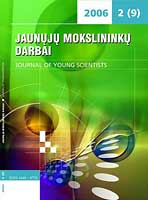Vidinė komunikacija Šiaulių universiteto socialinių mokslų fakultete: studentų nuomonių analizė
Internal Communication at the Social Sciences Faculty of Šiauliai University: Students’ Opinion Analysis
Author(s): Lina Bivainienė, Giedrė VielavičiūtėSubject(s): Social Sciences
Published by: VšĮ Šiaulių universiteto leidykla
Keywords: Internal communication; Social Sciences Faculty of Šiauliai University; students’ opinion.
Summary/Abstract: Well-timed, precise, qualitative information and ceaseless interchange of it among all the members in the organisation is needed for every organisation’s existence and effective management, however, frequently some obstacles arise which hinder effective communication, e. g., differences between the sender and the receiver, different cognition of reality, generalisations using false information, subjective conclusions, preconceived attitudes etc. The relevance of this article is related to the idea that interchange of information in the internal environment of the organisation is of no less importance than external communication with clients. The abilities to search for information, perceive the messages sent, etc. are one of the esential information management moments in the organisation. The problem is revealed by a problem question: What, according to the students’ opinion, are internal communication means frequently used at the Social Sciences Faculty of Šiauliai University, what are the advantages and disadvantages of them? The research object: internal communication and its means at the Social Sciences Faculty of Šiauliai University. The research aim: to investigate internal communication at the Social Sciences Faculty of Šiauliai University using students’ opinion analysis. The methods used in the work: analysis of scientific literature, questionnaire. Empiral research results disclosed that the respondents know best two main communication means used at the Social Sciences Faculty, i. e. messages on the noticeboards and the website of the Social Sciences Faculty. According to the respondents’ opinion, most information is given in the website of the Faculty (100%), and messages on the noticeboard (96%).
Journal: Jaunųjų mokslininkų darbai
- Issue Year: 2007
- Issue No: 5(16)
- Page Range: 7-14
- Page Count: 8
- Language: Lithuanian

